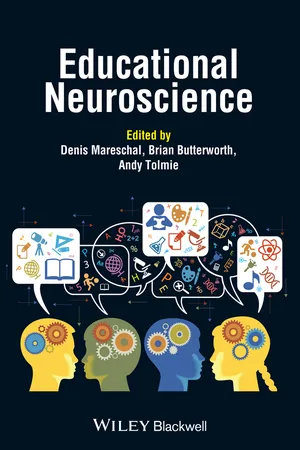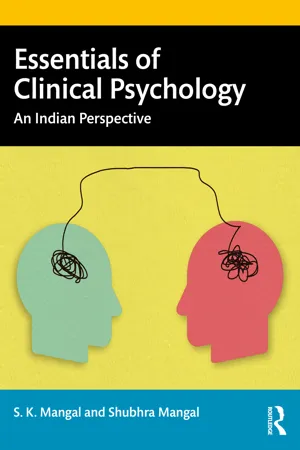Psychology
Research Methods in Psychology
Research methods in psychology refer to the systematic approaches used to investigate human behavior and mental processes. These methods include experiments, surveys, observations, and case studies, among others. By employing these methods, psychologists can gather empirical evidence to test hypotheses, make predictions, and draw conclusions about various aspects of human psychology.
Written by Perlego with AI-assistance
Related key terms
9 Key excerpts on "Research Methods in Psychology"
- Nancy Fenton, Jessica Flitter(Authors)
- 2015(Publication Date)
- Research & Education Association(Publisher)
Chapter 4 Research MethodsThe Scientific MethodAs an empirical science, psychology requires verifiable and objective data obtained through the use of the scientific method for the development of knowledge. The steps in the scientific method are outlined in Table 4.1. Psychologists begin the research process by evaluating existing evidence in order to develop a theory , or organized explanation for data, gained through empirical processes. The scientific method also requires the development of a testable and falsifiable prediction explaining the relationship between variables known as a hypothesis .To test the hypothesis, the experimenter must clearly define each of the procedures and variables being studied by creating operational definitions. Operational definitions state as precisely as possible what each variable means, including how it will be measured. The process of operationally defining variables is critical to the research process because it allows for replication , or having future psychologists repeat the exact procedures to obtain the same results. In order to reduce the risk that the results occurred by chance, all conclusions drawn from psychological research must be replicable.Table 4.1. Steps of the Scientific MethodResearch MethodsAs a science, psychology seeks to use empirical methods to observe and measure, predict, explain, and positively influence behavior. The descriptive methods relate to the functions of observation and measurement. Correlational studies make predictions, and experiments are designed to explain cause and effect relationships. When psychologists conduct basic research , the aim is to answer scientific questions and expand the overall information base of psychology. Applied research utilizes descriptive, correlational, and experimental designs to positively influence behavior and solve real-world problems.Population vs. Sample- Poul Rohleder(Author)
- 2012(Publication Date)
- SAGE Publications Ltd(Publisher)
There has been an increased diversity in the discipline of health psychology, with an increase in the use of diverse research methods, including qualitative research methods to explore issues of health and ill-health (Chamberlain & Murray, 2008). Qualitative methods have been found useful to explore and understand peoples’ experiences of illness and health, capturing the complexity of that experience and the complexities related to health care and promotion. Qualitative research methods have also been found to be a useful tool for advocating social change related to health and illness. Qualitative research methods have been less used in clinical psychology. Research in clinical psychology has been influenced by a medical approach, where randomized controlled trials and other quantitative research has been the preferred method for informing evidence-based practice. However, there has been a gradual increase in qualitative research in clinical psychology, particularly in the UK (as compared to the USA) (Harper, 2008). Qualitative methods have been found to be useful in understanding phenomena such as service user experiences, which traditionally was only taken into account when collecting a case history and investigating accounts of symptoms and their history. Increasingly, the experience of what it means and feels like to have mental health difficulties, or the experience of interactions with mental health services, has become an important focus of research.There are a number of qualitative research methods that are used in the social sciences and in psychology, and it is beyond the scope of this chapter to explore all or most of these in depth. Several books are available that detail the different methods used in qualitative research. Some recommended texts are listed at the end of this chapter. Here, I shall briefly outline some of the more commonly used methods used in health and clinical psychology, which are useful in taking a more critical approach to understanding issues in health and ill-health.DIFFERENT METHODS IN QUALITATIVE RESEARCH
8.2 A brief description of some of these methods and examples of their use in clinical and health psychology now follows. I have presented them, more or less, in terms of their historical inclusion in clinical and health psychology.8.2.1 PARTICIPATORY ACTION RESEARCH
Participatory action research is more a research approach than a specific method. It is normally included as a qualitative research method, in that it is concerned with capturing multiple perspectives and experience, as per the principles of social constructionism. Participatory action research aims to generate knowledge and practical solutions to problems affecting individuals and communities, through a process of participation and reflection with multiple partners (Kagan, Burton, & Siddiquee, 2008). The people who would typically be considered the ‘subjects’ of research actively participate in the generation of knowledge and seeking of practical solutions. The aim is to bring about social change, thus bringing together both the theoretical and the practical, and focuses on the individual as well as the social (be it, for example, the group, the community or the organization). In this sense, action research has as its primary purpose the production of “practical knowledge that is useful to people in the everyday conduct of their lives” (Reason & Bradbury, 2008: 4).- eBook - ePub
- Warren Davies(Author)
- 2013(Publication Date)
- Psychology Press(Publisher)
Does that mean that any study lacking a simple random sample is worthless? No, but it does mean that more care must be taken when generalizing the results to people outside that sample. Hey, you psychology students are free and available and you can be forced to take part in studies at little cost to the university. So why not use you? It's better to have those data than not have them. And of course, some things are more generalizable than others – research on perceptual systems perhaps, which probably operate similarly in psychology students as they do in any other adult population. Just make sure that, when conducting studies, you try to be as unbiased as you can and, when reading studies, you take a moment to note who the sample is and who they might generalize to (or not).OK, now that we have our participants, it's time to run the test.The experimental method
The experimental design is a research methodology used in psychology to look for cause-and-effect relationships between variables. It's not the only research design used but it is the best one for this particular purpose. Once you understand the logic of the experiment, it will be easier to understand other methods and their relative strengths and weaknesses; so we'll start here and then look at some different methods afterwards.An experiment is not just a general term used to describe any old test. The general idea of an experiment is to manipulate a particular variable while keeping other variables constant, then observe the effect this has on something else. What does it mean to hold other variables constant? Here's an example. I've heard that if you think you might be allergic to a certain food, the best thing to do is to remove things from your diet one at a time for a few weeks. If your symptoms clear up, you've found a good contender for the offending food group. If you cut out dairy, grains, processed meats and fruit all at the same time and then your symptoms clear up, how would you know which of the four you're allergic to? You wouldn't be able to tell. That's why you need to test them one at a time while keeping everything else constant. So you're keeping the other variables (other food groups) constant (eating them as normal) while you manipulate (stop eating) another. - Cengiz Erisen, Cengiz Erisen(Authors)
- 2016(Publication Date)
- Routledge(Publisher)
This special issue’s focus on research methodology in political psychology stems from the following reasoning: training on research methodology is essential for scholarly work. Today’s political science harbors several sub-disciplines such as political psychology, political behavior, comparative politics, and international relations all of which strongly rely on the proper use of methodology. It is critically important that scholarly work is designed in a way that employs a specific type of research tool to test its hypotheses or investigate its propositions. A set of hypotheses or propositions cannot be explored without a proper research design. This is critical not only for the improvement of the models depicting citizen behavior (in the case of political psychology and behavior) but also for the development of the discipline in general. Without proper methods of inquiry we cannot learn from our findings and cannot accumulate scientific knowledge.This article develops in three sections: first, experimental design as the most important method of inquiry in political psychology is discussed. Next, survey research with its main assumptions and the recent improvements to understand individual attitudes and behavior is explained. Finally, content analysis is examined.Experimental MethodExperimental method is the thriving research methodology within political science since the early 1990s. The number of articles implementing experimentation is exponentially increasing. There is also a growing debate about the methodology and its capabilities for research questions in political science. Recently, major books and handbooks are being published to explain and delineate certain aspects of the methodology.1 The development of political psychology within political science has initiated the interest on experimental studies. There is also a similar interest in social sciences in general: today, experiments are being used in economics and marketing. A growing number of studies are published on behavioral and experimental economics.2 In business administration, experiments are being increasingly used to delineate decision-making on day-to-day individual decisions as well as investment choices in the business market.3 Relatedly, decision-making literature primarily relies on experimental findings on decisions under uncertainty and time-constraints.4- eBook - ePub
- Matt Jarvis(Author)
- 2006(Publication Date)
- Routledge(Publisher)
10 Research methods in sport psychology
By the end of this chapter, you should able to:Learning objectives- understand the distinction between quantitative and qualitative research
- describe the experimental method and discuss its use in sport psychology research
- describe the correlational method and discuss its use in sport psychology
- describe survey methods, including questionnaires, interviews and focus groups, and discuss their use in sport psychology
- outline the case study method and discuss its use in sport psychology
- discuss the use of archived data in sport psychology research
- critically discuss the usefulness of systematic review and meta-analysis as ways of drawing conclusions from multiple studies.
This chapter is devoted to understanding the sort of research conducted in sport psychology. There are two purposes of this. First, it should give you a slightly deeper understanding of the research you will come across in this and other books whilst studying sport psychology. For example, you might wish to understand better why a study was done the way it was, or what the strengths and limitations are of the different research methods. Second, it should help you begin to plan your own research. There is no attempt to include everything you might ever want to know about carrying out research; that would be a book in itself, and there are several good books of that sort. However, it should give you a sound background in some basic principles.Quantitative and qualitative research
Hayes (2000) defines quantitative methods as those ‘which involve the manipulation of numerical data’ (p 239). In other words, the researchers are dealing with information in the form of numbers. Qualitative approaches, on the other hand, attempt to draw out the meanings - eBook - ePub
- Denis Mareschal, Brian Butterworth, Andy Tolmie, Denis Mareschal, Brian Butterworth, Andy Tolmie(Authors)
- 2013(Publication Date)
- Wiley-Blackwell(Publisher)
Chapter 5Research Methods in Educational Psychology
Andy TolmieDifferent Types of Approach to Educational ResearchTaken generically, mainstream educational research spans an extremely wide range of concerns, including school organization and effectiveness, pedagogy and classroom processes, educational technology and other forms of support for learning, special and inclusive education, and a variety of cross-cutting curricular specializations, such as science, mathematics, and literacy education. Given the importance attached to education and over a century’s history of active investigation of factors affecting educational outcomes, this diversity is unsurprising, though challenging for any attempt to summarize the research methods that have been employed.However, there is a more fundamental distinction between what may be termed “pure” educational research and psychological research in education. The former tends to be characterized by a concern with specific educational systems and structures, and the outcomes these produce. The latter is typically much less concerned with specific systems and contexts, being driven instead by a focus on the processes by which learning occurs, the factors that shape these processes, and how an understanding of both might be deployed within educational settings. Much research of this kind does not even take place within formal educational contexts, for instance making use of out-of-class or laboratory settings (e.g., Huss, Verney, Fosker, Mead, & Goswami, 2011; Philips & Tolmie, 2007), or concentrating on informal learning that takes place outside of school (e.g., Pino-Pasternak, Whitebread, & Tolmie, 2010).There is an inherently greater affinity between the methods and theoretical concerns of the neuroscience of learning and educational psychology: both are directed at understanding the basic processes of learning and the factors facilitating or constraining these. If educational neuroscience seeks to find points of convergence between the different research traditions, these are more likely to be found here than between neuroscience and pure educational research, at least at this point in time. This chapter will consequently focus predominantly on the methodologies employed within educational psychology. The next section deals with the issue of measurement, and the strategies that have evolved over time for capturing learning processes. The following section moves on to consider how these measurement techniques are deployed within different types of study design, including school-based interventions. Throughout the chapter a central goal will be to highlight the specific constraints that limit potential approaches to research in educational psychology as compared to the work in experimental cognitive neuroscience that features in other chapters. - eBook - ePub
- Graham C. Davey, Graham C. Davey(Authors)
- 2018(Publication Date)
- Wiley(Publisher)
- Enormous progress has been made in brain imaging techniques in recent years. Neuroscientists use data from techniques such as fMRI, EEG, and MEG to make inferences about cognitive, socio-cognitive, and emotional functioning.
- Opinions are mixed about the extent to which these techniques have provided genuine new insights into psychological functioning.
- Traditional behavioural measures retain many advantages: they are cheap and easy to use, and can be used with large numbers of participants.
- Ambulatory assessment makes use of portable event-recording devices (nowadays smartphones and iPads) to obtain data about behaviour in real time rather than retrospectively. Applications include measuring pain, stress, anxiety, mood, cigarette use, social phobia episodes, and dieting behaviour (to name just a few!).
- For decades, null hypothesis significance testing has been the dominant quantitative approach in psychology. Although it remains popular, it is gradually being supplanted by alternative approaches, such as Bayesian statistical methods. There is also a shift in emphasis from how likely results are to how sizeable and replicable they are.
CHAPTER SUMMARY
We are living in an exciting era, as far as Research Methods in Psychology are concerned. There seem to be challenges to the current approach to studying behaviour, which for decades has been dominated mainly by experimental studies in conjunction with quantitative statistical analyses using the NHST model. It remains to be seen whether there will be a paradigm shift in dealing with psychological data, comparable to the change from introspection to behaviourism, or from behaviourism to cognitive approaches.Whatever happens, the current diversity of methodologies being used to study human behaviour scientifically can only be a good thing, with both quantitative and qualitative approaches having something worthwhile to offer. There is also currently a healthy concern with how replicable and generalizable current psychological findings are. Again, this is something that can only be to the good of the discipline as a whole. - eBook - ePub
Essentials of Clinical Psychology
An Indian Perspective
- S. K. Mangal, Shubhra Mangal(Authors)
- 2023(Publication Date)
- Routledge(Publisher)
In the use of the method of meta-analysis, researchers try to have an appropriate statistical analysis of the results of independent research studies for arriving at a single conclusion helpful in answering a specific research question. For realizing its mission in a proper way, researchers are advised to make use of the systematic steps named as (i) Formulating the research question and establish the testable hypotheses, (ii) Obtaining a representative study sample in the form of selecting studies for being meta-analyzed, (iii) Extracting summary data or outcomes/findings from each study selected for meta-analysis, (iv) Doing analysis work, and (v) Deriving conclusions.Ethical Issues in Clinical Psychology Research
It is hoped as well as expected from researchers in all fields of knowledge to be sufficiently ethical in their research pursuit by following all the norms and values as needed on their part in this concern. Such need and expectations are more intensified in the cases of researchers carrying out investigation or research work in clinical psychology, where human behavior under distress is the focus and human beings are the subjects of the research study. In general, in this concern, the researchers in clinical psychology are required to pay attention to the ethical issues like: - eBook - ePub
- Miles Hewstone, Wolfgang Stroebe, Klaus Jonas, Miles Hewstone, Wolfgang Stroebe, Klaus Jonas(Authors)
- 2016(Publication Date)
- BPS Blackwell(Publisher)
Quasi-Experimentation: Design and Analysis Issues for Field Settings (1979, with Thomas D. Cook). Campbell argued that the sophisticated use of many approaches, each with its own distinct but measurable flaws, was required to design reliable research projects. The paper he wrote with Donald W. Fiske to present this thesis, ‘Convergent and discriminant validation by the multitrait–multimethod matrix’ (1959), is one of the most frequently-cited papers in the social science literature.Summary
Research strategies are broad categories of research methods that are available to study social psychological phenomena. We began by noting that it often makes sense to study a phenomenon using more than one strategy. We identified three quantitative strategies (experiments and quasi-experiments, and survey research) before discussing qualitative research strategies.A CLOSER LOOK AT EXPERIMENTATION IN SOCIAL PSYCHOLOGY
What are the main elements of a social psychological experiment?
Experimentation has been the dominant research method in social psychology, mainly because it is unrivalled as a method for testing theories that predict causal relationships between variables. Standard guides to research in social psychology (e.g., Aronson, Ellsworth, Carlsmith, & Gonzales, 1990; Aronson, Wilson, & Brewer, 1998) treat experimentation as the preferred research method. In fact there are some grounds for questioning the extent to which experimental studies provide unambiguous evidence about causation, as we shall see later.We will first describe the principal features of the experimental approach to social psychological research. To assist this process of description, we will use Milgram’s (1965; see Chapter 8) well-known study of obedience as an illustrative example.Features of the social psychological experiment
The experimental scenario is the context in which the study is presented. In laboratory settings it is important to devise a scenario for which there is a convincing and well-integrated rationale, because the situation should strike participants as realistic and involving, and the experimental manipulations and the measurement process should not ‘leap out’ at the participant. In Milgram’s study, participants were told that the study was an investigation of the effects of punishment on learning. The participant was given, apparently at random, the role of ‘teacher’, while an accomplice of the experimenter posing as another participant (known as a confederate
Learn about this page
Index pages curate the most relevant extracts from our library of academic textbooks. They’ve been created using an in-house natural language model (NLM), each adding context and meaning to key research topics.








